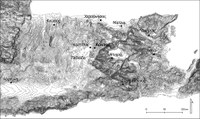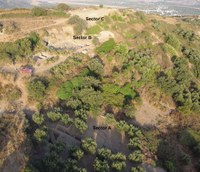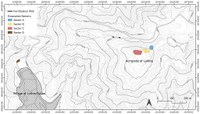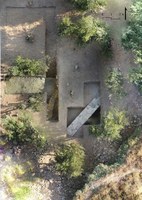Lyktos Archaeological Project
Co-directors: Professor Antonis Kotsonas (NYU Institute for the Study of the Ancient World) and Professor Angelos Chaniotis (Princeton Institute for Advanced Study)
 Figure 1: Map showing Lyktos' location in the Aegean
Lyktos was one of the most powerful cities of the Mediterranean island of Crete, Greece, in the Greek and Roman periods (Figure 1). The site is located in the hinterland of central Crete, southeast of ancient Knossos and modern Heraklion (Figure 2). The site occupies a tall and long hill, which rises to 620 meters above sea level. It is set between high mountains and a vast plain, and commands a view of north coast of the island and the Aegean Sea (Figure 3).
Figure 1: Map showing Lyktos' location in the Aegean
Lyktos was one of the most powerful cities of the Mediterranean island of Crete, Greece, in the Greek and Roman periods (Figure 1). The site is located in the hinterland of central Crete, southeast of ancient Knossos and modern Heraklion (Figure 2). The site occupies a tall and long hill, which rises to 620 meters above sea level. It is set between high mountains and a vast plain, and commands a view of north coast of the island and the Aegean Sea (Figure 3).
 Figure 2: Map showing Lyktos in its Cretan context
Celebrated by Homer and considered as the birthplace of god Zeus by the early poet Hesiod, Lyktos boasts an unusually rich literary and epigraphic record from Greek and Roman antiquity. Aristotle and other authors held that Lyktos was a colony of Sparta and deliberated the extent to which she was the source of the famed Spartan constitution. Lyktos was an arch rival of Knossos for several centuries, and the stealthy attack and dramatic sack of the city by the Knossians in 220 BCE captivated the ancient historian Polybius. Lyktos was quickly resettled, and by the Roman imperial period it was a major exporter of wine to Central Italy, and it attracted the sponsorship of emperors, especially Trajan and Hadrian, in the second century CE. In Early Christian times the city was the seat of a bishop but it declined over time and was abandoned during the Medieval period. The site has since remained largely unaffected by building activity and the surrounding landscape is basically pristine.
Figure 2: Map showing Lyktos in its Cretan context
Celebrated by Homer and considered as the birthplace of god Zeus by the early poet Hesiod, Lyktos boasts an unusually rich literary and epigraphic record from Greek and Roman antiquity. Aristotle and other authors held that Lyktos was a colony of Sparta and deliberated the extent to which she was the source of the famed Spartan constitution. Lyktos was an arch rival of Knossos for several centuries, and the stealthy attack and dramatic sack of the city by the Knossians in 220 BCE captivated the ancient historian Polybius. Lyktos was quickly resettled, and by the Roman imperial period it was a major exporter of wine to Central Italy, and it attracted the sponsorship of emperors, especially Trajan and Hadrian, in the second century CE. In Early Christian times the city was the seat of a bishop but it declined over time and was abandoned during the Medieval period. The site has since remained largely unaffected by building activity and the surrounding landscape is basically pristine.
 Figure 3: Aerial view of Lyktos acropolis from the northeast
Notwithstanding the rich textual record for Lyktos, and the interest of many renowned archaeologists in excavating it, the site has attracted very limited and only small-scale fieldwork. The Lyktos Archaeological Project (LAP) was established in 2021 to explore the untapped potential of the site for Classical studies and Mediterranean archaeology, and aims at generating a longue durée urban history of the ancient city, ranging from its probable foundation in the end of the Bronze Age to its abandonment in the Medieval period. The project is co-directed by ISAW’s Antonis Kotsonas and Professor Angelos Chaniotis, from the Institute for Advanced Study at Princeton; it involves the collaboration of Dr. Vasiliki Sythiakaki, from the Greek Archaeological Service, runs under the auspices of the Archaeological Society at Athens, and encompasses both fieldwork and the study of archaeological material previously unearthed at Lyktos. The project team is diverse and includes specialist collaborators, and graduate and undergraduate students from ISAW/NYU and other institutions in North America and Europe.
Figure 3: Aerial view of Lyktos acropolis from the northeast
Notwithstanding the rich textual record for Lyktos, and the interest of many renowned archaeologists in excavating it, the site has attracted very limited and only small-scale fieldwork. The Lyktos Archaeological Project (LAP) was established in 2021 to explore the untapped potential of the site for Classical studies and Mediterranean archaeology, and aims at generating a longue durée urban history of the ancient city, ranging from its probable foundation in the end of the Bronze Age to its abandonment in the Medieval period. The project is co-directed by ISAW’s Antonis Kotsonas and Professor Angelos Chaniotis, from the Institute for Advanced Study at Princeton; it involves the collaboration of Dr. Vasiliki Sythiakaki, from the Greek Archaeological Service, runs under the auspices of the Archaeological Society at Athens, and encompasses both fieldwork and the study of archaeological material previously unearthed at Lyktos. The project team is diverse and includes specialist collaborators, and graduate and undergraduate students from ISAW/NYU and other institutions in North America and Europe.
 Figure 4: Map of LAP excavation sectors
Ancient Lyktos was vast in size (100 hectares by a certain estimate), but LAP has targeted specific areas which shed light on key aspects of the Greek, Roman and Byzantine periods (Figure 4). Any longue durée approach to Cretan urban histories faces the problem of the low archaeological visibility ca. 625–425 BCE, which has been conceptualized as a “Dark Age” for the island, or as the time of the “Archaic gap”. The ISAW/NYU team working at Lyktos has targeted this period and is revealing an exceptional wealth of finds from the alleged “Dark Age,” at both settlement and burial areas. The settlement area (location Vorina) we are excavating lies on the upper north slope of the acropolis of Lyktos, and has yielded evidence for occupation ranging from the Early Iron Age to the Medieval period, including thick stratified deposits of the 6th to 4th centuries BCE (Figure 5).
Figure 4: Map of LAP excavation sectors
Ancient Lyktos was vast in size (100 hectares by a certain estimate), but LAP has targeted specific areas which shed light on key aspects of the Greek, Roman and Byzantine periods (Figure 4). Any longue durée approach to Cretan urban histories faces the problem of the low archaeological visibility ca. 625–425 BCE, which has been conceptualized as a “Dark Age” for the island, or as the time of the “Archaic gap”. The ISAW/NYU team working at Lyktos has targeted this period and is revealing an exceptional wealth of finds from the alleged “Dark Age,” at both settlement and burial areas. The settlement area (location Vorina) we are excavating lies on the upper north slope of the acropolis of Lyktos, and has yielded evidence for occupation ranging from the Early Iron Age to the Medieval period, including thick stratified deposits of the 6th to 4th centuries BCE (Figure 5).
 Figure 5: Aerial photograph of excavated multi-period context
The rich ceramic finds, which include copious imports from Attica and other Aegean regions (Figure 6), and the associated large quantities of animal bone are indicative of feasting activities, perhaps in the context of the famous syssitia (the ritualized dining) of the men from Lyktos (Athenaios 4.143). The burial location, which dates to the late 7th and 6th centuries BCE, lies west of the acropolis (location Alonas), and presents unusual funerary rites, and locally produced and imported objects. Our work there is the first systematic excavation of a Cretan cemetery dating from this period.
Figure 5: Aerial photograph of excavated multi-period context
The rich ceramic finds, which include copious imports from Attica and other Aegean regions (Figure 6), and the associated large quantities of animal bone are indicative of feasting activities, perhaps in the context of the famous syssitia (the ritualized dining) of the men from Lyktos (Athenaios 4.143). The burial location, which dates to the late 7th and 6th centuries BCE, lies west of the acropolis (location Alonas), and presents unusual funerary rites, and locally produced and imported objects. Our work there is the first systematic excavation of a Cretan cemetery dating from this period.
 Figure 6: Attic pottery fragments from the excavation
The archaeological investigation of Lyktos in later periods of antiquity is spearheaded by the project co-directors, who excavate on the acropolis of the site: In Sector B, Professor Angelos Chaniotis is revealing a public building complex of the Roman imperial period, which includes an assembly hall, as well as a space lined with statue bases and inscriptions for emperors of the Antonine dynasty and their spouses. In Sector C, on the top of the acropolis of Lyktos, Dr. Vasiliki Sythiakaki is revealing a large and richly adorned Early Christian Basilica. Given its location, and its size and decorative elaboration, the monument could have been the seat of the local bishop.
Figure 6: Attic pottery fragments from the excavation
The archaeological investigation of Lyktos in later periods of antiquity is spearheaded by the project co-directors, who excavate on the acropolis of the site: In Sector B, Professor Angelos Chaniotis is revealing a public building complex of the Roman imperial period, which includes an assembly hall, as well as a space lined with statue bases and inscriptions for emperors of the Antonine dynasty and their spouses. In Sector C, on the top of the acropolis of Lyktos, Dr. Vasiliki Sythiakaki is revealing a large and richly adorned Early Christian Basilica. Given its location, and its size and decorative elaboration, the monument could have been the seat of the local bishop.
Publications
- Kotsonas, A. (2019). Politics, Research Agendas and Abortive Fieldwork Plans over Lyktos, Crete: A History of Archaeological Research. Annual of the British School at Athens, 114, 399–443.
- Kotsonas, A. (2021). Lyktos. In Oxford Classical Dictionary.
- Kotsonas, A., Sythiakaki, V., & Chaniotis, A. (2021). Ανασκαφή Λύκτου. Πρακτικα Της Εν Αθηναις Αρχαιολογικης Εταιριας, 176, 213–264.
- Galanaki, Κ., and Α. Chaniotis, eds. Forthcoming. Proceedings of the International Conference Λύκτος εϋκτιμένη. Heraklion.